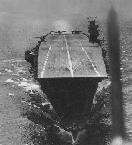Von Rom
Posts: 1705
Joined: 5/12/2000
Status: offline

|
The B-17s are too powerful in the game.
The 43rd Bomb Wing first began training and flying some antisubmarine patrols along the New England coast with B-17, B-18, A-29 and LB-30 aircraft. In February 1942, it moved to the southwest Pacific and was assigned to Fifth Air Force, where it would operate from August 1942 to Nov. 1944. First equipped with B-17s and LATER CONVERTING TO THE B-24 IN MID-1943, the 43rd operated from bases in Australia, New Guinea and Owi Island, making numerous attacks on Japanese shipping in the Netherlands East Indies and the Bismarck Archipelago.
The group also experimented with skip bombing during this time and used this method for some shipping strikes, including attacks on Japanese vessels during the Battle of the Bismarck Sea March 2-4, 1943, in which repeated air attacks destroyed a large enemy convoy carrying reinforcements to New Guinea. Please note that this convoy was made up mainly of troop transports and about 8 destroyers.
After the Bismarck Sea engagement, "Ken's Men" turned their attention toward the reduction of enemy airdromes in New Guinea and New Britain and destruction of shipping in the neighboring waters. Targets hit in the succeeding weeks included Wewak, Madang, Rapopo, Arawe, and Casmata. Most of those attacks were carried out by a small number of planes because most of the Group's B-17's had been damaged in the Battle of the Bismarck Sea [and this against just destroyers. What would have happened to the B-17s if they had attacked cruisers and battleships with their AA?).
The unit's diary on 19 March noted: Reinforcements have been taking place at all enemy airdromes and General Kenny [Commanding General of the Fifth Air Force] is in Washington trying to get more planes and men over here to help us out. Our planes are badly shot up, but the boys still love 'em."
Few if any of the Group's attacks against Rabaul in 1943 were carried out against shipping because the Japanese were making greater use of the more distant harbor at Kavieng, New Ireland.
The most devastating anti-shipping blow of April and May 1943 was directed against a convoy which had been tracked to Kavieng. In a period of four days beginning on 1 April, 21 B-17's of the 43rd Group and 9 B-24's (probably from the 90th Group) harassed ships AT ANCHOR in Kavieng harbor. The B-24's dropped 500-pound bombs from 5,000 feet and observed large explosions. Some of the 43rd Group's B-17's also attacked from medium altitude, but the Fortresses skip-bombing from 75 to 250 feet caused the greatest damage. The official reports indicated that a 6,000-ton vessel was "left sinking," and two to four destroyers were damaged. That mission, which General Douglas MacArthur described as "a honey," considerably reduced the enemy's capabilities of supplying its beleaguered garrisons in New Guinea.
COMMENT:
In the above, please note that most attacks by B-17s were against merchant shipping, slow troop transports or lightly guarded convoys. Many of these attacks (and the most successful ones) were against Japanese ships AT ANCHOR IN HARBOUR.
I have never been aware in the real war of low level B-17s attacking Japanese cruisers, battleships or aircraft carriers on the open sea and living to tell the tale. . .
Even when the B-17s attacked Japanese destroyers, they took such heavy damage that most of them were out of commission because of needed repairs. Why? Because they were BIG, SLOW moving targets. . .
_____________________________
|
 Printable Version
Printable Version










 New Messages
New Messages No New Messages
No New Messages Hot Topic w/ New Messages
Hot Topic w/ New Messages Hot Topic w/o New Messages
Hot Topic w/o New Messages Locked w/ New Messages
Locked w/ New Messages Locked w/o New Messages
Locked w/o New Messages Post New Thread
Post New Thread